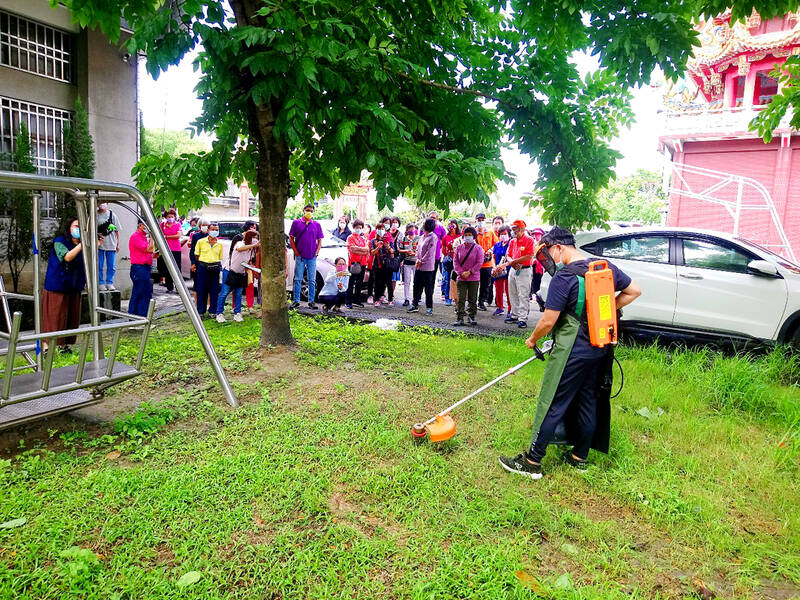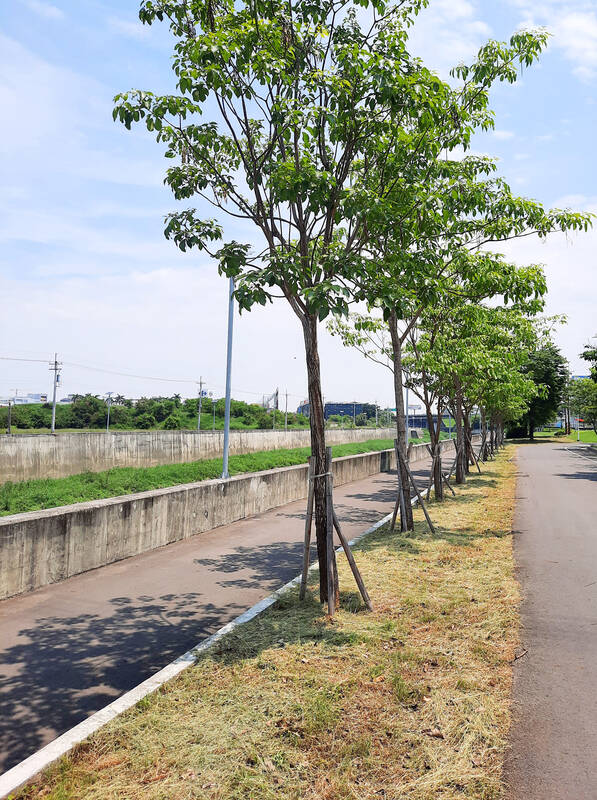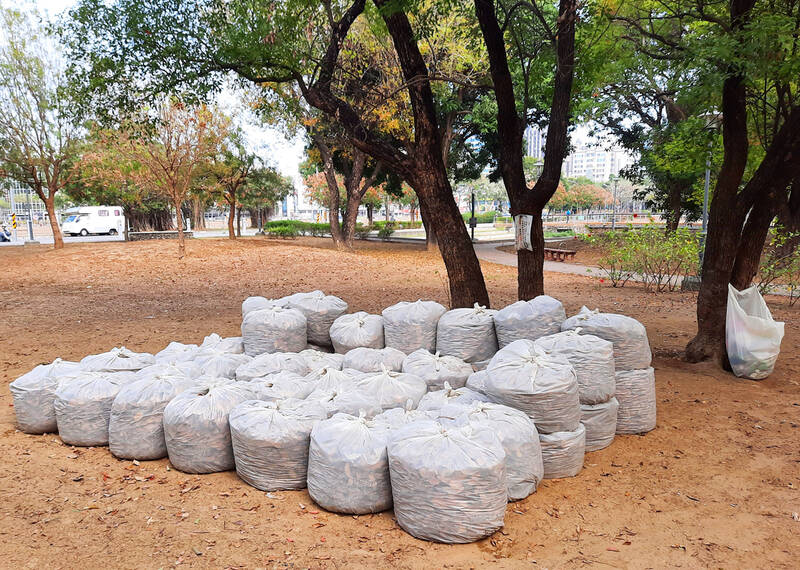Like many hashtags, #NoMowMay is both an inspiration and an oversimplification.
In the UK — where the movement started — and in those parts of North America where it’s caught on, #NoMowMay urges nature-conscious people to let patches of grass under their control grow wild, so that bees, butterflies and other pollinators can enjoy a temporary habitat and access to food until flowers become abundant at the beginning of summer.
According to the Web site of Plantlife, a conservation charity that manages 24 nature reserves in the UK, #NoMowMay is “one of the easiest ways to help and connect with wildlife, and the perfect way to start supporting nature in your garden.”

Photo: Chen Wen-chan, TaipeiTimes
Encouraging urban landowners to join the effort, the NGO stresses that even a plot the size of a ping-pong table can help give nature “the best start to summer.”
LET NATURE TAKE ITS COURSE
Few Taiwanese have lawns, of course. What’s more, Taiwan’s climate is rather different from Britain’s. Here, several plant species produce flowers (and thus nectar) in fall or winter. But the principle of noninterference, of letting nature take its course, certainly holds lessons for the ways in which the authorities manage parks, curb strips and other public spaces.

Photo: Steven Crook
Speaking on condition of anonymity, a contractor for a local government in southern Taiwan says that the grassy areas they look after are usually mown twice a month, because when grass reaches a height of 8cm, “it looks untidy.”
The contractor says that mowing can help grass grow better. One reason is that it stimulates grass plants to produce more side shoots, creating a thicker lawn. Another is that taller grass is more likely to develop seed heads, which diverts resources from leaf and root growth.
Seed heads can make a patch of grass look unkempt, but they’re the part of the plant that provides food and shelter to pollinators. They also attract birds who feed on the seeds or the insects that gather around them.

Photo: Steven Crook
A lawn of uniform height is pleasing to the eye, but research indicates that the opposite is better for biodiversity. Longer grass provides certain species with protection against predators and extreme temperatures, while shorter grass is better for creatures that need to forage or which prefer open areas.
CRITICS
#NoMowMay has its critics, and they’re not just individuals who want parks to look like bowling greens. An article republished by Popular Science on May 17 last year asserts that “restoring biodiversity requires more than doing less.” It mentions studies which found that: unmowed plots don’t support significantly more flowers compared to plots where the grass is kept short; that “restored” grasslands have far less plant diversity than landscapes which have never been seriously disturbed; and that, if the goal is getting native wildflowers to establish themselves, rather than simply seed a lawn, it’s best to first kill the grass with herbicide.
Grass isn’t the only target of overzealous maintenance crews. Particularly in places where people worry about dengue fever, fallen leaves are assiduously removed from parks and sidewalks.
From an epidemiological perspective, this makes complete sense. Accumulations of leaves can prevent water from draining, and mosquitoes don’t need a lot of water in which to breed — an upturned bottle cap is enough. But if healthy ecosystems are a priority, it’s the wrong approach, according to environmentalist groups such as the Society of Wilderness (SOW, 荒野保護協會).
In a Nov. 11 Facebook post, SOW argued that, while many people regard leaf litter as trash that should be cleared away, leaves play an important role in park ecology, making a positive contribution to soil health.
The NGO’s post explained that, as they decompose, leaves increase soil fertility which in turn benefits trees and plants. They protect soil from erosion during heavy rainfall, and slow the rate at which it dries out when the sun is shining.
They also act as a buffer, ameliorating the problem of soil hardening caused by human trampling. Compacted soil is impermeable to air and water; this undermines the microbial ecosystem and increases runoff.
The contractor says that, while some people think fallen leaves enhance the landscape, there are others who call the citizens’ service hotline and complain whenever they come across leaf litter.
“If there are a lot of fallen leaves, it means you’ve not fulfilled your duty of cleaning and maintenance, so you must sweep them up,” they add.
The use of leaf blowers instead of rakes is especially lamentable, because they injure grasshoppers and crickets while eroding topsoil.
SOW says if there are so many leaves on a pathway that people may slip, the obvious thing to do is to push them into the flowerbeds. Adding them to a compost pile is another solution. There’s no need to bag them up and send them for disposal elsewhere.
SOW hopes its supporters can help the public understand that “leaf litter may not look like much, but it’s key to making parks more ecologically diverse and soils healthier.” Transporting and incinerating leaves with household garbage is an unnecessary burden on municipal budgets, the NGO says.
How much of a burden is hard to say, however. According to the contractor, there are no statistics on the quantity of fallen leaves carted away from public spaces each year. It’s a different matter when it comes to branches collected from parks and roadsides. These have an economic value, as they can be ground into sawdust for mushroom-growing substrate.
BIOGAS
Since 2022, the city of Amiens in northern France has shown that incineration and in situ decomposition aren’t the only options when dealing with fallen leaves. The municipality trucks them to a nearby facility where — once plastic, metal and other trash has been removed — they’re degraded in digester vats to create methane-rich biogas. This is then burned in a cogeneration plant that produces both heat and electricity.
Taiwan is developing biogas infrastructure, but most of what’s been built so far is optimized for manure from pig farms.
One person who’s expressed the hope that Taiwan’s parks can be a little wilder is Cheng Wan-chi (鄭婉琪). In an opinion piece republished by the Environmental Information Center (環境資訊中心) on July 20, 2021, she argued that, “if we want to bring the concept of ‘natural play’ back to urban green spaces and parks, what needs to be redesigned isn’t the hardware… but the software” — in other words, the management of such places.
She urged parents to teach their children that earthworms live in soil and that fallen leaves can nourish the land. By designing the right tasks and activities, she added, “parents and children can take care of the land together.”
Steven Crook, the author or co-author of four books about Taiwan, has been following environmental issues since he arrived in the country in 1991. He drives a hybrid and carries his own chopsticks. The views expressed here are his own.

Cheng Ching-hsiang (鄭青祥) turned a small triangle of concrete jammed between two old shops into a cool little bar called 9dimension. In front of the shop, a steampunk-like structure was welded by himself to serve as a booth where he prepares cocktails. “Yancheng used to be just old people,” he says, “but now young people are coming and creating the New Yancheng.” Around the corner, Yu Hsiu-jao (饒毓琇), opened Tiny Cafe. True to its name, it is the size of a cupboard and serves cold-brewed coffee. “Small shops are so special and have personality,” she says, “people come to Yancheng to find such treasures.” She

In July of 1995, a group of local DJs began posting an event flyer around Taipei. It was cheaply photocopied and nearly all in English, with a hand-drawn map on the back and, on the front, a big red hand print alongside one prominent line of text, “Finally… THE PARTY.” The map led to a remote floodplain in Taipei County (now New Taipei City) just across the Tamsui River from Taipei. The organizers got permission from no one. They just drove up in a blue Taiwanese pickup truck, set up a generator, two speakers, two turntables and a mixer. They

Former Chinese Nationalist Party (KMT) chairwoman Hung Hsiu-chu’s (洪秀柱) attendance at the Chinese Communist Party’s (CPP) “Chinese People’s War of Resistance Against Japanese Aggression and the World Anti-Fascist War” parade in Beijing is infuriating, embarrassing and insulting to nearly everyone in Taiwan, and Taiwan’s friends and allies. She is also ripping off bandages and pouring salt into old wounds. In the process she managed to tie both the KMT and the Democratic Progressive Party (DPP) into uncomfortable knots. The KMT continues to honor their heroic fighters, who defended China against the invading Japanese Empire, which inflicted unimaginable horrors on the

Hannah Liao (廖宸萱) recalls the harassment she experienced on dating apps, an experience that left her frightened and disgusted. “I’ve tried some voice-based dating apps,” the 30-year-old says. “Right away, some guys would say things like, ‘Wanna talk dirty?’ or ‘Wanna suck my d**k?’” she says. Liao’s story is not unique. Ministry of Health and Welfare statistics show a more than 50 percent rise in sexual assault cases related to online encounters over the past five years. In 2023 alone, women comprised 7,698 of the 9,413 reported victims. Faced with a dating landscape that can feel more predatory than promising, many in